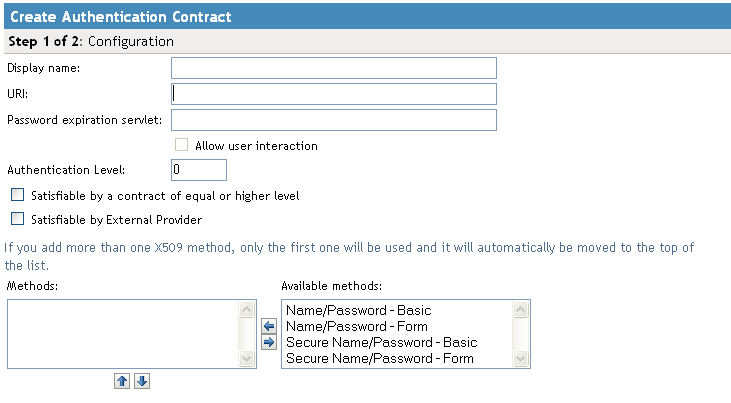2.4 Configuring Authentication Contracts
Authentication contracts define how authentication occurs. An Identity Server configuration might have several authentication contracts available, such as name/password or X.509, which is used for mutual SSL authentication between the Identity Server and the Access Gateway. Resources at an Access Gateway or agent are protected by authentication contracts.
NOTE:You cannot delete a contract if it is in use by an Access Gateway or J2EE agent.
Contracts are executed by the identity provider when authenticating a user. A URI uniquely identifies each contract, and you can assign authentication methods to each contract. A single contract can be specified for local logins.
-
In the Administration Console, click > > > > >
-
Click .

-
Fill in the following fields:
Display name: Specifies the name of the authentication contract.
URI: Specifies a value that uniquely identifies the contract from all other contracts. For example, as an identity provider, you might want to publish the details of a contract. In this case, you can use a URL so that the link resolves to a page. No spaces can exist in the URI field.
Password expiration servlet: Specifies a URL to a page where the user can change his or her password. This applies only to eDirectory servers when the password is expired or within the grace login period. You must use eDirectory to change the number of grace logins.
For more information about how use this type of servlet, see Section 2.5, Using a Password Expiration Service.
Allow User Interaction: If you specify a password expiration servlet, you can enable this option, which allows the users to decide whether to go to the servlet and change their passwords or to skip the servlet. If you always want to force the users to go the servlet to change their passwords, do not enable this option.
Authentication Level: A number you can assign to this authentication contract to specify its security level or rank. You use this setting to preserve authentication contracts of a higher security level. When you enable the option on this page, the system uses this value as a reference.
For example, you might create a name/password authentication contract and assign it to level one. You might also create an X.509 authentication contract and assign it to level two. If a user supplies the credentials for the X.509 level-two contract, the system does not require the credentials to satisfy the name/password level-one authentication contract.
Satisfiable by a contract of equal or higher level: Allows the system to satisfy this authentication contract if a user has logged in using another contract of an equal or higher authentication level, as specified in the field of an authentication contract.
Satisfiable by External Provider: Allows this contract to be selected when configuring an identity provider for Liberty or SAML 2.0. When configuring the authentication request, you can select a contract that has this option enabled and require the identity provider to use this contract in order for authentication to succeed.
Methods and Available Methods: Specifies the authentication method to use for the contract. You can specify the order in which the methods are executed for login; however, this is not a graded list, so all the methods you specify are required. are the authentication methods you have set up.
If you add more than one X.509 method, only the first one is used and it is automatically moved to the top of the list.
When choosing a secure method, such as Secure Name/Password, ensure that you have enabled security for the Identity Server configuration by setting the protocol to HTTPS. See
Configuring Secure Communication on the Identity Server
in the Novell Access Manager 3.1 SP1 Setup Guide. -
Click .
-
Configure a card for the contract by filling in the following:
ID: (Optional) Specify an alphanumeric value that identifies the card. If you need to reference this card outside of the Administration Console, you need to specify a value here. If you do not assign a value, the Identity Server creates one for its internal use.
Text: Specify the text that is displayed on the card to the user.
Image: Specify the image to be displayed on the card. Select the image from the drop down list. To add an image to the list, click .
Show Card: Determine whether the card is shown to the user, which allows the user to select and use the card for authentication. If this option is not selected, the card is only used when a service provider makes a request for the card.
-
Click , then .
-
Update the Identity Server and any devices that use the Identity Server configuration.
-
To use this contract, you must configure Access Manager to use it:
-
You can assign it as the default contract for the Identity Server. See Section 2.6, Specifying Authentication Defaults
-
You can configure a protected resource to use it. See
Configuring Protected Resources
in the Novell Access Manager 3.1 SP1 Access Gateway Guide.
-